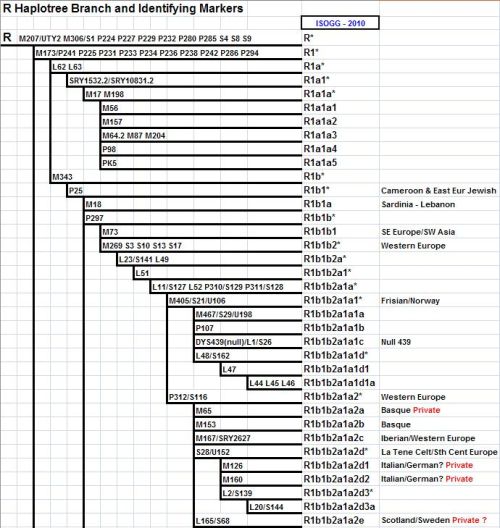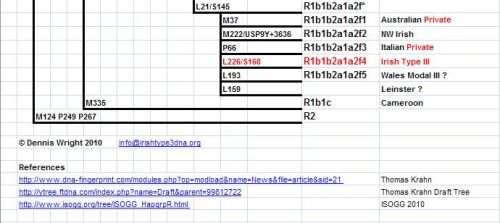Irish Eyes - Vol 10
Welcome to this addition of Irish Eyes, 30 May 2008, I hope you enjoy reading it. The original Irish Type III Website was set up in December 2006 and since that time has swapped names and servers a couple of times. A total of 245 records of Irish Type III cluster members have been gathered in that time. There have been over 4700 hits to the site. You are receiving this email as you are a member of this cluster.
A New Website for Irish Type III
The original website of December 2006 and the second of January 2008, were hosted on free website host Yahoo Geocities. Being free, there were restrictions on their use, and two weeks ago I inadvertently fell foul of a paragraph in their 24 page "Terms of Service" and without ceremony, the website was closed down by Yahoo. I was devastated! All the files were on my computer but I had no host!
Several members quickly offered to host the website in my hour of need, and I must thank Roger Townsend for setting up the website on a temporary basis until I could do something more permanent. Thank you Roger.
Now our cluster has a proper domain name, and a new host. The new site is www.irishtype3dna.org Having purchased a domain name and now paying to have the site hosted, I am back in full control of the site and what I post to it. Also, there are no more annoying advertisements and having to push them away on each page as with the last site. I hope it will be an easier name to remember and be a more enjoyable experience. I can be contacted by .
Text Size
In keeping with many websites, I have chosen a smaller font size for a smarter, less clunky look for all pages. If you are finding the characters a little small, most browsers have a facility to increase the viewing font size. For Internet Explorer, View > Text Size > Larger and for Firefox, View > Text Size > Ctrl ++
Another defining marker
It has been found the marker DYS716, which is available from FTDNA under "Advanced Orders", Panel 4, has a distinctive value of 24 for members of our cluster. All six Irish Type III people who have tested have recorded 24 but most of the rest of R1b, (49 from 52 results) record a value of 26 and there are no other "24s" except us! So if you test 24 at DYS716, you are most likely to be "Irish Type III".
YCC2008 and ISOGG R Haplotype Trees and a new SNP
Recently the YCC (Y-Chromosome Consortium) has released the 2008 version of the R-Tree defining the various clades of "R" haplogroup. The only problem is that days before, a new SNP S116/rs34276300 was returning test results.
It appears that S21, old R1b1c9, is ancestral (-ve) while all other R1b1c clusters are testing derived (+ve) and so the YCC2008 was out of date before it was released.
The 2009 ISOGG tree has also now been published which does include S116/rs34276300 and L21/S145. http://www.isogg.org/tree/ISOGG_HapgrpR09.html
Here is my take on the R-Tree, using data from both sources.


October 2011: The above chart is no longer relevant. Please refer to ISOGG R-Tree instead as this is kept up-to-date.
New Naming Design
I believe the time has come for a new naming design, as the above is getting quite unwieldy. I was R1b1c* and in the tree above, I would become R1b1b2a1b6*.
I feel that the naming should state R1b and then list the last positive SNP. For example I would be R1b-L21*, the asterisk indicating that I have tested -ve for ALL SNPs below L21.
If you have not tested ALL SNPs below S116 you would be R1b-S116 without the asterisk. If you haven't tested S116 yet but all other SNPs are -ve then you would be R1b-M269.
New Age Calculation for the Cluster
I have completed another run to estimate the age of the cluster with 81 x 67 marker haplotypes. As is normal, the fast moving markers are deleted, DYS385, 389, 459, 464 and CDY and using John Chandler/Leo Little's Mutation rates, an age of 1086 years ±20% was obtained.
25 Testing and the search for a new SNP for our Cluster.
Still no results from EthnoAncestry of our testing and a recent email from them follows:-
Dear Dennis,
My apologies again for the delay. It is down to the following reasons:
1) The sequence around the SNP is repetitive and our sequencing reactions were initially not optimised for this and so failed to read through the repeats, we need to see all the way through to be able to align correctly, the snp is almost in a microsatellite.
and
2) We had a problem with the sequencer stopping too early in a run.
Both issues have been resolved and we are currently waiting for what will hopefully be high quality data containing all your results.
With best wishes
Dr. Gianpiero Cavalleri
... let's hope that we don't have to wait too much longer.
If any members have comments, suggestions or an article that you would like to write for Irish Eyes please drop me a line .... warning, this flyer may not be too regular !!
Slainte, Dennis Wright

